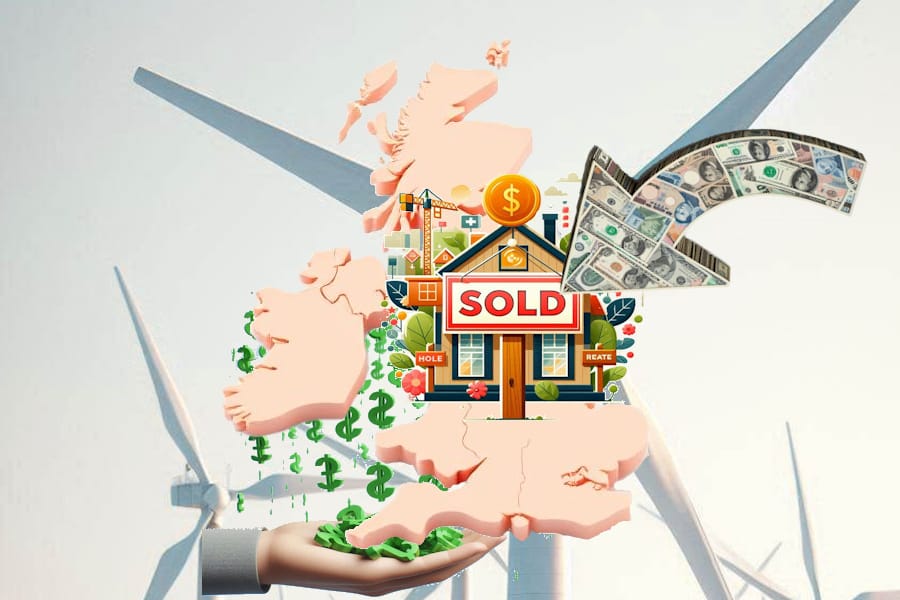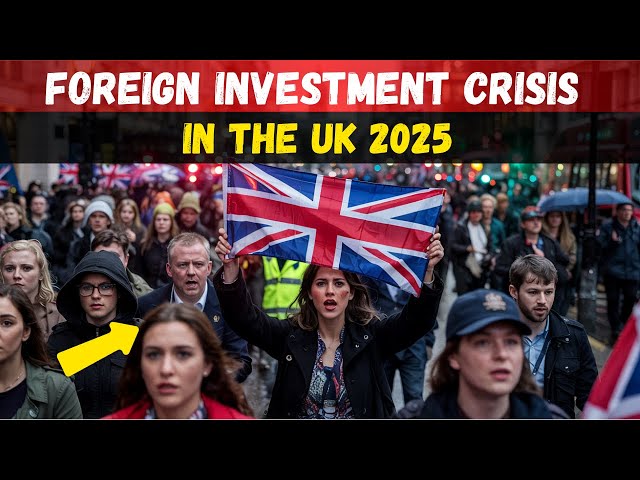Britain’s FDI Trap
Energy Stability to Reclaim Economic Control

Publish Date: Last Updated: 1st June 2025
Author: nick smith - With the help of GROK3
LONDON — Britain’s economy thrives on a staggering £2.08 trillion in foreign direct investment (FDI), making it Europe’s top destination for foreign capital. Yet, this financial lifeline hides a dangerous trap: £106.9 billion in profits flow abroad annually, leaving taxpayers to shoulder burdens like Thames Water’s £14 billion debt. Foreign ownership permeates critical sectors—water, energy, rail—driven by tax hikes and labor laws that push investors toward quick profits in public contracts and housing. But the real crisis lies in energy. The April 2025 blackout in Spain and Portugal, triggered by grid instability amid heavy renewable reliance, serves as a stark warning. To break free, Britain must prioritize affordable, reliable energy over rushed carbon targets, investing in domestic gas and oil to power homes, steel factories, and economic sovereignty. This is the story of how Britain got hooked, why energy stability is the solution, and the roadmap to reclaim control.
The FDI Boom: A Double-Edged Sword
For 15 years, Britain has led Europe in attracting FDI, securing 1,555 greenfield projects in 2023/24, creating 52,200 jobs, according to the Department for Business and Trade. The United States, contributing 26% of FDI in 2021, and the EU have fueled London’s financial skyscrapers, Manchester’s tech hubs, and Birmingham’s automotive plants. From 2014 to 2023, inward FDI stock grew from £1.17 trillion to £2.08 trillion, per the Office for National Statistics (ONS). This influx has modernized infrastructure and driven innovation, but it comes with a catch.
Foreign-owned firms generated £106.9 billion in profits in 2023, up £9 billion from 2022, with £30.2 billion from utilities like water and energy alone. Much of this—particularly from US firms, which repatriated $285.3 billion globally in 2023—leaves as dividends. The UK’s net international investment position, measuring foreign assets against liabilities, was negative £225.5 billion, signaling more money exits than stays. In 2023, FDI inflows dropped to £22.9 billion from £78.8 billion in 2022, as Brexit uncertainties and global competition bit.
“It’s like borrowing to pay the rent,” says Sarah Jones, a 42-year-old Sheffield steelworker facing layoffs as her foreign-owned plant cuts costs. “The cash comes in, but our communities don’t see the benefits.”
Thames Water: A Symbol of Profit Over People
Thames Water, serving 15 million customers, epitomizes FDI’s dark side. Privatized in 1989 with zero debt, it was acquired in 2006 by a Macquarie-led consortium for £8 billion. By 2017, when Macquarie sold its stake, debt had ballooned to £10.8 billion, driven by financial engineering, per company filings. From 2006 to 2015, Thames paid £1.6 billion in dividends to foreign owners, including Canadian pension funds and Abu Dhabi’s sovereign wealth fund, while underinvesting in infrastructure. Today, its £14 billion debt—80% of its asset value—threatens collapse, with taxpayers potentially footing the bill if renationalized.
“My water bills have doubled in a decade, but the pipes still leak,” says John Carter, a 68-year-old London pensioner. A 2023 YouGov poll found 69% of Britons support public ownership of water, reflecting anger at foreign profit extraction. England’s water sector, 72% foreign-owned, generates £2.5 billion in profits annually, much of it flowing offshore. Similar patterns plague energy and rail, where French, German, and Chinese firms dominate.
Tax Hikes and Labor Laws: Skewing the Game
The Labour government’s 2024 budget raised capital gains tax from 20% to 24% for higher earners and private equity “carried interest” from 28% to 32%, aiming to fund schools and hospitals. New labor laws strengthened worker protections, including a 7% minimum wage hike and expanded union rights. While these benefit workers, they increase costs, deterring investment in low-margin sectors like manufacturing, which saw a 14% drop in FDI projects in 2023.
Investors are instead flocking to high-yield areas: public sector contracts (£300 billion annually), housing (boosted by planning restrictions), and energy (where foreign firms repatriate £10 billion yearly, per ONS). These sectors offer stable returns, but prioritize shareholder payouts over long-term investment, as Thames Water’s crumbling infrastructure shows.
“Foreign investors want quick, safe profits,” says Emma Patel, an economist at the Institute for Public Policy Research. “Tax hikes make factories less appealing, so they chase contracts or utilities.”
Spain’s Blackout: A Renewable Reality Check
On April 28, 2025, Spain and Portugal endured a catastrophic blackout, plunging 55 million people into darkness for over 18 hours—Europe’s worst in decades. Spain’s grid operator, Red Eléctrica, reported two generation losses in solar-heavy southwest Spain, causing a 15-gigawatt drop—60% of demand—in five seconds, destabilizing the grid and severing ties with France. While cyberattacks were ruled out, the grid’s reliance on renewables (60% solar, 12% wind at the time) exposed vulnerabilities. Spain’s renewable share, 56% of electricity in 2024, outpaced grid upgrades, leaving it prone to frequency imbalances, unlike gas or nuclear plants that stabilize grids, per The Guardian.
“The blackout wasn’t solely renewables’ fault, but their volatility strained an unprepared grid,” says Antonio Turiel, a Spanish energy researcher. Britain, with 40% of its electricity from renewables in 2023, faces parallel risks. Household energy bills, averaging £3,000, and industrial tariffs, among Europe’s highest, have crippled steelmakers like Tata, which cut 2,800 jobs in 2024. Foreign-owned energy firms, charging premium rates, exacerbate the strain.
“We can’t run factories or heat homes if the power’s unreliable,” says Mark Evans, a 35-year-old Manchester electrician. “Green dreams don’t help when the grid fails.”
Global Context: Britain’s Energy Lag
Britain’s energy woes contrast with peers. Germany, with €1.5 trillion in FDI, powers its €1.6 trillion export economy with a balanced mix of gas, nuclear, and renewables, maintaining a 20% manufacturing GDP share versus Britain’s 10%, per Eurostat. Norway’s state-owned Equinor delivers affordable domestic energy, reinvesting profits locally. The Netherlands, a tax haven, channels FDI into infrastructure. Britain, however, struggles. Brexit trade barriers and high energy costs deterred investors, costing £32.3 billion in manufacturing FDI in 2023. Globally, FDI fell 12% in 2023, per UNCTAD, as nations like China prioritize energy security.
The US’s $369 billion Inflation Reduction Act lured green investment away from Europe, while Britain’s rush to renewables without grid upgrades mirrors Spain’s misstep. “Energy stability is the backbone of any economy,” says Patel. “Britain’s playing catch-up.”
The Energy Crisis at Home
Britain’s energy instability is a domestic disaster. The steel industry, vital for infrastructure and jobs, is collapsing under energy costs. Port Talbot’s Tata Steel plant, facing closure, supports 8,000 jobs directly and 12,500 in supply chains. High tariffs—£100/MWh versus Germany’s £70/MWh—make UK steel uncompetitive. Households, too, suffer: 6.5 million faced fuel poverty in 2024, per the End Fuel Poverty Coalition. Foreign energy firms, owning 60% of UK electricity generation, repatriate £10 billion annually, leaving little for grid modernization.
The government’s 2030 net-zero target, aiming for 95% low-carbon electricity, has driven renewable growth but neglected reliability. Wind and solar, while clean, depend on weather and lack the “inertia” of gas or nuclear to stabilize grids. The National Grid’s 2024 report warned of potential supply shortfalls by 2028 without new capacity. Spain’s blackout underscores the urgency.
A Roadmap for Energy Stability and Economic Control
Britain can escape its FDI trap by securing reliable, affordable energy, balancing carbon goals with pragmatism. Here’s a detailed plan, with trade-offs and practical steps:
-
Domestic Gas and Oil Investment: Partner with private firms to build North Sea gas and oil rigs, pricing energy at operational costs (£50–£70/MWh) rather than global markets (£100/MWh). Norway’s Equinor powers homes and industry affordably, supporting 50,000 jobs.
-
Trade-Off: New rigs could delay carbon targets, risking EU trade penalties or carbon tariffs by 2027.
-
First Step: Fund a £2 billion North Sea gas pilot by 2026, targeting 10% bill reductions for 5 million households and 500 industrial firms.
-
Feasibility: The North Sea Transition Authority estimates 1.4 billion barrels of recoverable oil and gas, enough for 15 years of domestic supply.
-
-
Pragmatic Carbon Transition: Replace 2030 net-zero deadlines with technology-driven goals, deploying renewables only when storage—like batteries at £100/kWh by 2030—is cost-effective. France’s nuclear fleet, supplying 70% of electricity, cuts emissions without blackouts.
-
Trade-Off: Slower green progress may anger climate activists and delay EU alignment.
-
First Step: Invest £500 million in grid-scale battery trials in Scotland by 2027, stabilizing 20% of renewable output.
-
Feasibility: The UK’s 2024 battery storage capacity (2.8 GW) can scale to 15 GW by 2030 with targeted funding, per Aurora Energy Research.
-
-
Smart Public Procurement: Tie £300 billion in public contracts to local energy use and job creation. A “Buy British” rule could boost steel demand by 700,000 tonnes yearly, supporting 10,000 jobs.
-
Trade-Off: WTO rules limit protectionism, potentially raising contract costs by 5–10%.
-
First Step: Secure £1.5 billion in rail contracts for Alstom’s Derby plant by 2026, saving 1,300 jobs.
-
Feasibility: The 2008 Automotive Assistance Program saved 3,000 jobs, proving procurement’s power.
-
-
Public Ownership of Utilities: Nationalize water and energy to halt £12.5 billion in annual profit outflows, using the 1991 Water Industry Act to minimize shareholder payouts. Scotland’s public water system saves £100 million yearly.
-
Trade-Off: Upfront costs, estimated at £50 billion, could strain NHS or education budgets.
-
First Step: Renationalize Thames Water by 2027, capping debt at £10 billion and saving £200 million annually in dividends.
-
Feasibility: Public support (69% per YouGov) and legal precedents ease the path.
-
-
Skills and Productivity: Fund 100,000 apprenticeships by 2030 in energy and manufacturing, boosting productivity 15%, as France’s training programs demonstrate.
-
Trade-Off: £2 billion in training costs may divert funds from immediate job creation.
-
First Step: Launch 10,000 energy apprenticeships in 2025, targeting 50% youth unemployment reduction in industrial regions.
-
Feasibility: The UK’s 2023 apprenticeship levy generated £3.5 billion, sufficient for expansion.
-
Overcoming Barriers
Implementing this plan faces hurdles. Politically, Labour’s fiscal caution post-2022’s Truss crisis limits borrowing, and Brexit trade barriers complicate procurement. Globally, competition for energy investment is fierce, with the US and China offering subsidies. Public opinion, while supportive of nationalization, resists new taxes or bill hikes. Yet, precedents exist: Norway’s Equinor, France’s nuclear success, and Scotland’s water model show what’s possible. A phased approach—pilots, targeted funding, and public-private partnerships—can mitigate risks.
Voices of the Affected
Stakeholders underscore the urgency. “Stable energy means jobs,” says Sarah Jones, whose steel plant faces closure. “Foreign owners don’t care about us.” John Carter, the pensioner, adds, “I’m tired of paying for their profits.” Mark Evans, the electrician, warns, “Without reliable power, businesses shut down.” Spanish expert Antonio Turiel cautions, “Britain must learn from our blackout—renewables need a strong grid.” Emma Patel concludes, “Energy is the foundation. Get it wrong, and the economy crumbles.”
A Defining Choice
Britain’s FDI trap—£106.9 billion in profits bleeding out—threatens its future. Thames Water’s debt, Tata’s job cuts, and Spain’s blackout signal the stakes. By investing in domestic gas and oil, prioritizing energy stability, and tightening public contracts, Britain can retain its wealth. But it’s a tightrope. Global markets, carbon commitments, and budget constraints demand precision. As Patel says, “Energy stability is the bedrock—without it, we’re at the mercy of foreign powers.”
The path forward requires adult conversations, not ideological crusades. Britain must act now to power its people, industries, and sovereignty—or risk a blackout of its own.
Followup YouTube Videos

Is Net Zero Causing Higher Electricity Prices?
YouTube Channel: Economics Help

Is Chinese investment in Europe a threat or opportunity?
YouTube Channel: Roundtable

Is the UK’s Economy Relying Too Much on Foreign Investment?
YouTube Channel: Globe Track

How India is Buying the United Kingdom's Largest Companies
YouTube Channel: Behind Asia
Latest News Articles
AI Questions and Answers section for Britain’s FDI Trap
Welcome to a new feature where you can interact with our AI called Jeannie. You can ask her anything relating to this article. If this feature is available, you should see a small genie lamp in the bottom right of the page. Click on the lamp to start a chat or view the following questions that Jeannie has answered relating to Britain’s FDI Trap.
Be the first to ask our Jeannie AI a question about this article
Look for the gold latern at the bottom right of your screen and click on it to enable Jeannie AI Chat.













